Nitamago・煮卵
Nitamago is also called Ajitama・味玉 in ramen shops.
Nitamago / Ajitama means seasoned (boiled) egg in Japanese.
Have you ever seen or tried a ramen egg? An egg that is seasoned beautifully and nice and runny on the inside? That is Nitamago! (Or sometimes called Ajitama in ramen shops in Japan). How do they make it so flavorful and perfectly textured you ask? Well, you are going to find out now! It is so easy to make, and you only need a few ingredients.
These are the ingredients and tools you will need for this recipe:
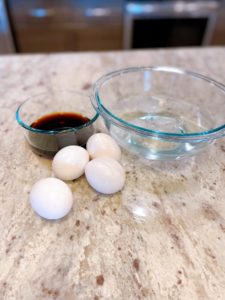
Yes, there is a soy sauce-looking liquid in the picture, but it’s actually something else! It is called Mentsuyu (or sometimes just Tsuyu). Mentsuyu is a Japanese noodle soup base. When you go shopping for this at an Asian grocery store, you may find a huge selection of Japanese noodle soup base, and it may be overwhelming. So let me introduce my favorite brand to you:
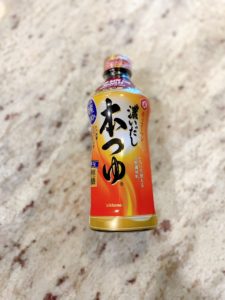
This is my favorite. You should be able to find this at most Asian grocery stores, and of course in any grocery store in Japan. Here is a link for it if you don’t have Asian grocery stores near you, or if you’d just rather buy it online (Kikkoman Hontsuyu Soup Base: https://amzn.to/3phdv0H).
If you can’t find this brand, no problem! Any of the Japanese noodle soup tsuyu bases will flavor the eggs just fine. Some may have stronger taste than others, but you can always add water to it to make it to your liking. No need to stress!
3 Tips for Making Nitamago:
- Boiling: 6 minutes of boiling the eggs is going to make the yolk perfectly runny. If you don’t like the runny texture though, try boiling the eggs a minute or two longer to get the yolks set just a little bit more.

- Swirling: Swirling the eggs a couple of times while they are boiling will help the yolks set in the center. This prevents the yolk from resting too close to the egg shell.
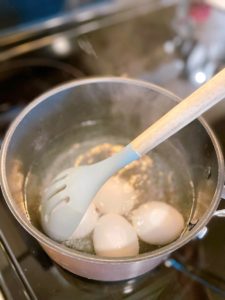
- Cooling: Keep the water cool by changing water or adding more ice cubes. This will help stop the eggs from overcooking once they’re done, and it will help you perfect your favorite runny yolk texture. It also helps you crack the eggs since they won’t be too hot!

3 Tips for Peeling Egg Shells
Be very very gentle! After cooking for 6 minutes, the egg whites are perfectly cooked and solid. However, the yolks aren’t set, so the egg is still going to be soft and easy to break. To avoid breaking, try these tips:
- Crack the egg shells all around, one at a time on a hard surface (like the kitchen counter), and then put them back in the cold water bath. Letting each egg soak while you work on the others will allow the water to seep in between the broken shells and eggs for an easy peel.

- Some shells may feel stuck as you are peeling. Rather than trying to force them to peel, gently crack the shell on a hard surface a little bit more, and put it back in the water to try again later.

- Sometimes, when it breaks, it breaks. And that’s okay! Don’t panic; just marinate it in a separate bag or bowl. Maybe make it a Nitamago don by putting it on rice when it’s ready. It will still taste yummy!

Nitamago・煮卵 (Ajitama・味玉)
Ingredients
- 4 eggs
- 3 tbsp mentsuyu (tsuyu) Japanese noodle soup base
- 1-2 tbsp water
Cold water bath
- ice cubes for cooling eggs
- cold water for cooling eggs
Instructions
- In a pot, boil enough water to cover eggs.
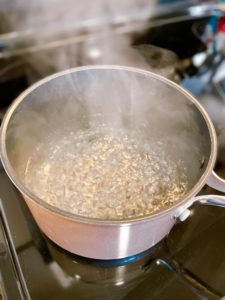
- Gently place eggs into boiling water using a ladle, and boil for 6 minutes. (This will make a very runny yolk.) Swirl a couple of times while boiling to help set yolks near the center.
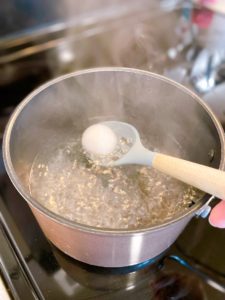
- While the eggs are boiling, pour the mentsuyu and water into a small ziploc bag (sandwich bag size) or tupperware. Also prepare the cold water bath in a bowl with ice cubes.

- Using a ladle, take out the eggs from the boiling water and cool them in the cold water bath. Leave them in the ice water for a few minutes. If the water becomes warm, add more ice cubes or change the water to keep the temperature cold.
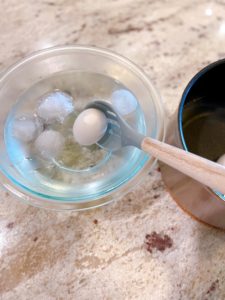
- For an easy peel, very gently crack the eggs all over and put them back in the cold water bath to let the water come in between the shells and eggs.

- Peel very slowly and gently. Once the eggs are completely peeled, put them in the mentsuyu bag/tupperware.

- Let the eggs marinate in the refrigerator for at least 1 hour before eating. If necessary, turn the eggs in the container for an even color and flavor.
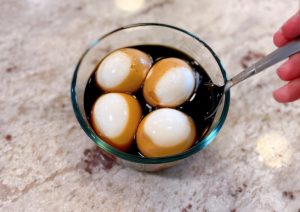
Video
@deni.pan Tips for making Nitamago (ajitama)😌 #tips #easyrecipe #nitamago #ajitama #japanesefood #japanese #ramenegg #煮卵 #味玉 #煮玉子 #おうちごはん #cookingwithdenipan
♬ She Share Story (for Vlog) – 山口夕依
Notes
As an Amazon Associate I earn from qualifying purchases.




